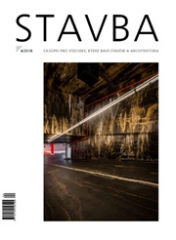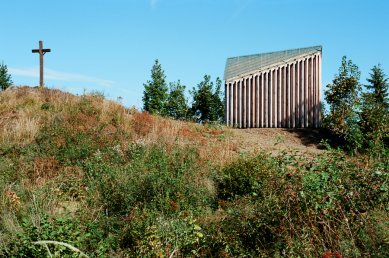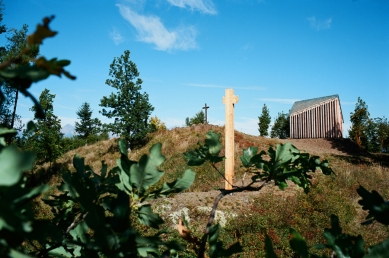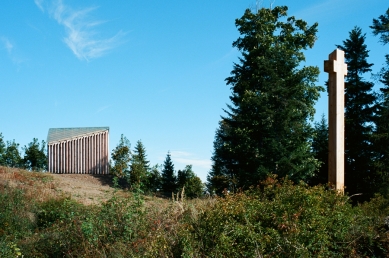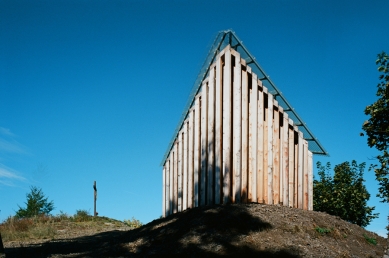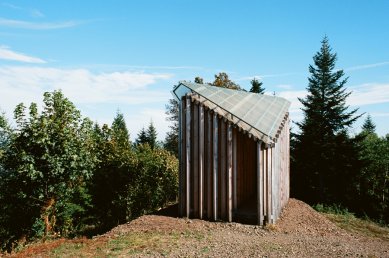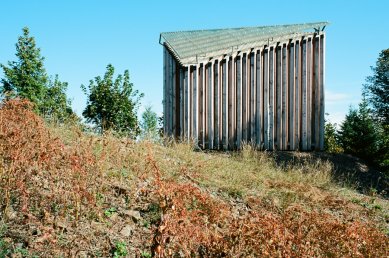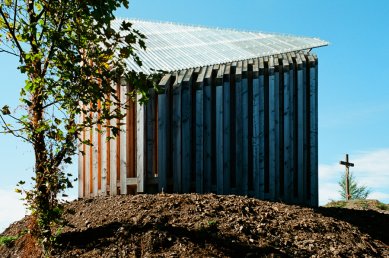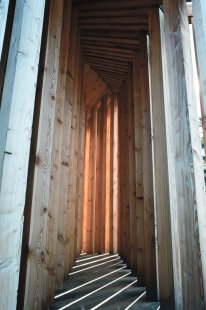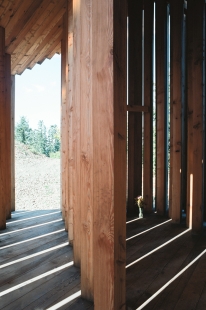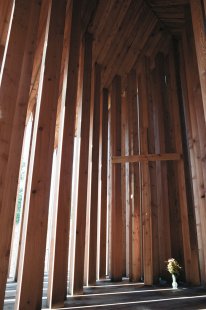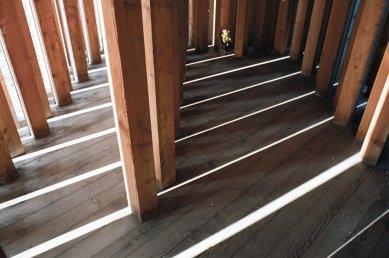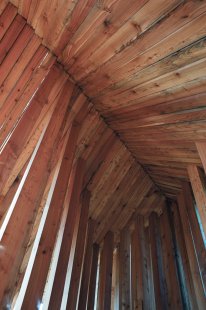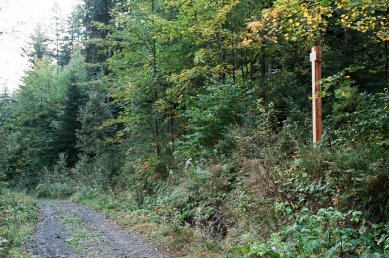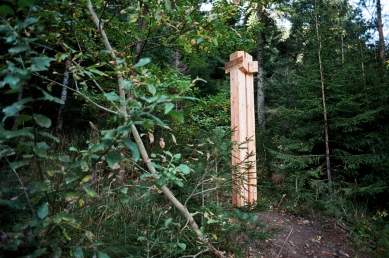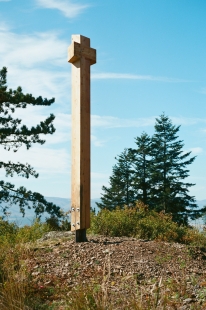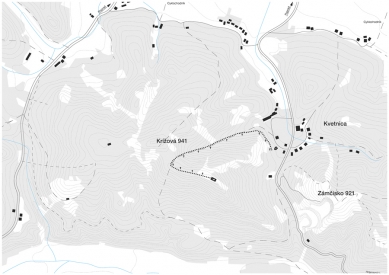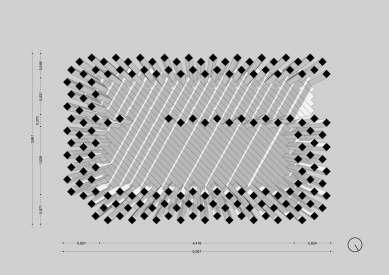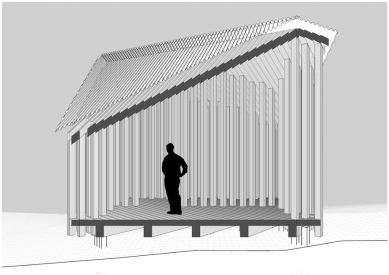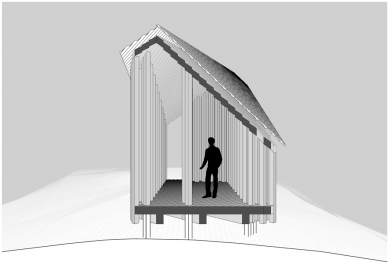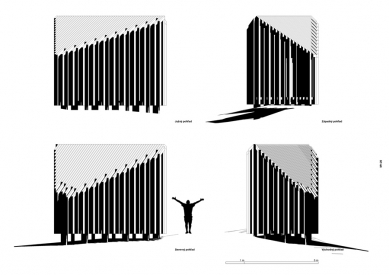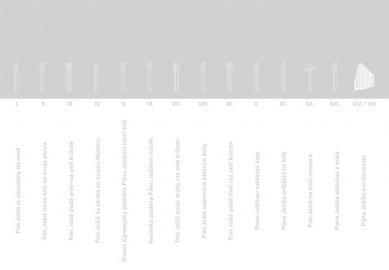
Chapel and Stations of the Cross Poprad

I pondered for a long time what the first step would be. After a whole day of walking, I realized that I hadn't even noticed it. I contemplated for a long time what it would be like – to reach the destination. We ran the last kilometer. We didn't feel the fatigue after 900 kilometers traveled in our legs. Together with good friends Vojtech and Vavrinec, we arrived at the tomb of St. James just as the Sunday noon bells rang. Twenty-four days without a watch or a mobile phone, and yet we arrived to the minute precisely! What a coincidence... A few days later, I am already sitting at home under the Tatras. Gradually and very slowly, it dawns on me what I actually experienced over the past month. All the more was I disappointed that I didn't feel the end after all. I wanted to know the answer, but it didn't come.
I thought about how I could tell the story that I experienced on the Camino de Santiago. I don't know how to write, it won't be a book. I also didn't want to post photos on Facebook. As an architect, I had the desire to offer a short pilgrimage to anyone who needs it.
In 2009, when the crisis was just starting, I met two investors who would finance a small field concrete chapel. As it often happens, the money for a small construction didn't materialize, and the project was to end up in a drawer. We tried to reach out to other people, tried other places and parishes, but we didn't succeed.
A year later, I met a person with a similar dream. The director of the City Forests of Poprad, Robert Dula, wanted to build a calvary above the local part Kvetnica. The hill couldn't have a more fitting name than Cross.
For the first time, we began searching for a place where the chapel could stand in the summer of 2011. On the neighboring peak, we found a magical spot with a view of the city and surrounding mountains. The following year, we sought a suitable path through occasional outings.
The original design of the concrete chapel was conceived as a striking object set somewhere in the Spiš fields. The white concrete was supposed to shine from afar, similar to the church tower in the village of Mlynica. The situation on the hill was different. The open space gave way to the intimacy of the forest, and the pilgrim does not come from all sides but only along one path. The chapel is not just a stop; it is the end of the Way of the Cross and the tomb of God. Eighteen massive red spruces from these forests were donated by the city, and we never even considered using any material other than wood. The verticality and material of the trees transformed their form into architecture.
The wall prevents light from entering the room. In the smoky cathedral in Santiago de Compostela, a bright sunbeam pierced through an opening under the dome. The window illuminates the interior. It is a clear symbol of where the eye turns when it wants to escape from darkness. Four massive walls without windows that also let the sunlight in represent the metaphor of God's presence in our lives. God is here in every moment and detail. It only depends on us whether we notice His glimpse and begin to follow it. The space of the chapel represents our limited world, beyond which there may be another, perfect, and infinite one. The only link between these worlds is light. The movement of the sun across the sky creates a dynamic play of light and shadow in the interior. Its complexity of rhythms and seemingly monotonous repetition resembles the compositions of Steve Reich. The piece "Proverb" captures this unstable light image best. The initially archaic chant of the choral is interspersed with new patterns of rhythms, and a simple line gradually expands into an unprecedented layering.
The construction is based on a unique arrangement of about a hundred columns. Their mutual position creates a massive wall that the human eye cannot overlook and isolates the person from the surrounding nature. On the contrary, the sharp and precise sun shines through small crevices into the interior and loans it an unparalleled atmosphere at every moment.
A separate chapter of the design was the foundation. The chapel, nearly at a thousand meters above sea level, is a perfect reflection of the strength of human faith. If any future generation turns away from nurturing the values of the spirit, the wooden ark will return to nature once again. Only the chessboard-arranged concrete footings will remain in the ground. Like the trace of culture, like the tomb of God. Someone else who decides to restore the sanctuary can build a new temple on the found foundations. It will be physically linked to the original one.
To fine-tune the chapel down to the last detail, so that the base footings, floor beams, columns, ceiling, steel trusses, and transparent covering form one whole, was not an easy task, but it was by far not as challenging as securing funding.
After presentations and pilgrimages to the hill, we tried to launch local crowdfunding, and people could contribute any amount to the account. This didn’t go very well, and so the parish donated the proceeds from a Sunday collection in the churches. We built the foundations and for a long time paused. Despite our efforts, the money wasn’t increasing as we had hoped. Eventually, we met a person who decided to donate his life savings. I didn't believe it. He only had one condition. The chapel should be made of stone. The charm of translucent wooden walls would be lost. We caught him in the forest and showed him the project on site. The moment I pulled out the model, the sun came out for two minutes. The play of light and shadow convinced him. The rest of the day was again foggy autumn. A coincidence...
From the donation, we financed the wooden part. The chapel stood again for a year without completion. Even the unfinished project didn’t help us in obtaining further funds more easily. Last year, we realized the steel roof frame, and this spring we installed the transparent corrugated laminate roofing by ourselves. The larch wood has nicely grayed in the meantime and better blends in with nature. However, the interior of the chapel has retained its red color, which evokes memories of dark Gothic cathedrals filled with the colorful light of stained glass. A local sculptor, Otto Korkoš, is working on the wooden statue of the resurrection of Christ, whose work is rooted in the legacy of Master Paul from Levoča.
I thought about how I could tell the story that I experienced on the Camino de Santiago. I don't know how to write, it won't be a book. I also didn't want to post photos on Facebook. As an architect, I had the desire to offer a short pilgrimage to anyone who needs it.
In 2009, when the crisis was just starting, I met two investors who would finance a small field concrete chapel. As it often happens, the money for a small construction didn't materialize, and the project was to end up in a drawer. We tried to reach out to other people, tried other places and parishes, but we didn't succeed.
A year later, I met a person with a similar dream. The director of the City Forests of Poprad, Robert Dula, wanted to build a calvary above the local part Kvetnica. The hill couldn't have a more fitting name than Cross.
For the first time, we began searching for a place where the chapel could stand in the summer of 2011. On the neighboring peak, we found a magical spot with a view of the city and surrounding mountains. The following year, we sought a suitable path through occasional outings.
The original design of the concrete chapel was conceived as a striking object set somewhere in the Spiš fields. The white concrete was supposed to shine from afar, similar to the church tower in the village of Mlynica. The situation on the hill was different. The open space gave way to the intimacy of the forest, and the pilgrim does not come from all sides but only along one path. The chapel is not just a stop; it is the end of the Way of the Cross and the tomb of God. Eighteen massive red spruces from these forests were donated by the city, and we never even considered using any material other than wood. The verticality and material of the trees transformed their form into architecture.
The wall prevents light from entering the room. In the smoky cathedral in Santiago de Compostela, a bright sunbeam pierced through an opening under the dome. The window illuminates the interior. It is a clear symbol of where the eye turns when it wants to escape from darkness. Four massive walls without windows that also let the sunlight in represent the metaphor of God's presence in our lives. God is here in every moment and detail. It only depends on us whether we notice His glimpse and begin to follow it. The space of the chapel represents our limited world, beyond which there may be another, perfect, and infinite one. The only link between these worlds is light. The movement of the sun across the sky creates a dynamic play of light and shadow in the interior. Its complexity of rhythms and seemingly monotonous repetition resembles the compositions of Steve Reich. The piece "Proverb" captures this unstable light image best. The initially archaic chant of the choral is interspersed with new patterns of rhythms, and a simple line gradually expands into an unprecedented layering.
The construction is based on a unique arrangement of about a hundred columns. Their mutual position creates a massive wall that the human eye cannot overlook and isolates the person from the surrounding nature. On the contrary, the sharp and precise sun shines through small crevices into the interior and loans it an unparalleled atmosphere at every moment.
A separate chapter of the design was the foundation. The chapel, nearly at a thousand meters above sea level, is a perfect reflection of the strength of human faith. If any future generation turns away from nurturing the values of the spirit, the wooden ark will return to nature once again. Only the chessboard-arranged concrete footings will remain in the ground. Like the trace of culture, like the tomb of God. Someone else who decides to restore the sanctuary can build a new temple on the found foundations. It will be physically linked to the original one.
To fine-tune the chapel down to the last detail, so that the base footings, floor beams, columns, ceiling, steel trusses, and transparent covering form one whole, was not an easy task, but it was by far not as challenging as securing funding.
After presentations and pilgrimages to the hill, we tried to launch local crowdfunding, and people could contribute any amount to the account. This didn’t go very well, and so the parish donated the proceeds from a Sunday collection in the churches. We built the foundations and for a long time paused. Despite our efforts, the money wasn’t increasing as we had hoped. Eventually, we met a person who decided to donate his life savings. I didn't believe it. He only had one condition. The chapel should be made of stone. The charm of translucent wooden walls would be lost. We caught him in the forest and showed him the project on site. The moment I pulled out the model, the sun came out for two minutes. The play of light and shadow convinced him. The rest of the day was again foggy autumn. A coincidence...
From the donation, we financed the wooden part. The chapel stood again for a year without completion. Even the unfinished project didn’t help us in obtaining further funds more easily. Last year, we realized the steel roof frame, and this spring we installed the transparent corrugated laminate roofing by ourselves. The larch wood has nicely grayed in the meantime and better blends in with nature. However, the interior of the chapel has retained its red color, which evokes memories of dark Gothic cathedrals filled with the colorful light of stained glass. A local sculptor, Otto Korkoš, is working on the wooden statue of the resurrection of Christ, whose work is rooted in the legacy of Master Paul from Levoča.
MArch Samuel Netočný
The English translation is powered by AI tool. Switch to Czech to view the original text source.
3 comments
add comment
Subject
Author
Date
Pekné
Matej Farkaš
01.11.16 11:41
Bravo!
pavlik.t
03.11.16 04:19
Parádička, gratulace
Ondřej Bartůšek
10.05.17 10:36
show all comments


